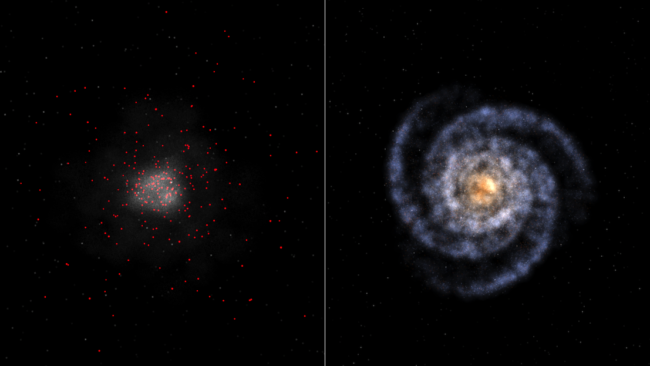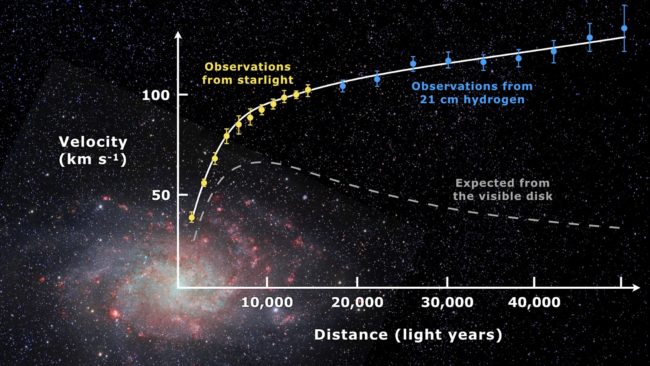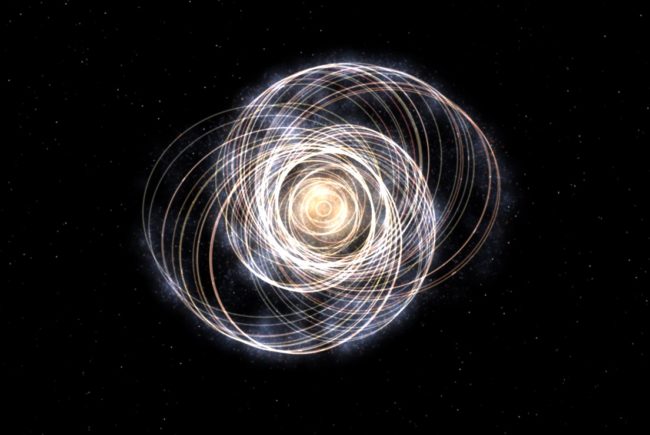Dark Matter & Galaxies in Universe Sandbox

You may notice that our new galaxy model (added in Update 23, released on June 25, 2019) no longer includes those bright red dots. The dots were how we represented dark matter in the old galaxy model (pre-Update 23), but we’ve decided not to include dark matter in the new model, for a number of reasons.
Short Explanation
Here’s the TL;DR explanation of why we removed dark matter in our new galaxy model:
Dark matter is a theoretical particle proposed to explain the unexpected motion of stars in galaxies. Due to performance constraints, our simplified galaxy dynamics model can’t simulate these complex orbits, so we’ve decided to remove dark matter from our simulations for now.
If you’re looking for a more in-depth explanation, keep reading!

Left: Spiral galaxy with dark matter (pre-Update 23). Right: Spiral galaxy in Update 23.
What is dark matter?
No one knows for sure what dark matter is, or even if it exists! But a number of different observations of our universe have revealed stars and galaxies moving under the gravitational influence of more mass than we can see. This hints at the presence of some kind of matter that affects stars and other bodies via gravity, but that can’t be observed directly. This proposed “dark matter” doesn’t produce light, but it also doesn’t block it, or we would be able to see it silhouetted against brighter stars and galaxies in the background (like we can see dust in the Milky Way).
We don’t know of a type of particle that has mass but that doesn’t interact with light, but a few ideas have been proposed. It may be a new type of particle that we haven’t discovered yet, and several ongoing experiments are trying to directly detect such a particle. Some scientists argue that dark matter does not exist at all, and that the “missing mass” in astronomical observations simply indicates that our mathematical description of gravity is not yet complete.
What does this have to do with galaxies?
Spiral galaxies were one of the first examples of the missing mass problem. Astronomers discovered the problem while calculating the “rotation curve” for these galaxies: a plot of the velocity of a star orbiting in the galaxy, versus the distance of that star to the center of the galaxy. The speed at which an object orbits in space is related to the mass of everything inside its orbit, and the distance to the center of the orbit. In the Solar System, nearly all of the mass inside a planet’s orbit is made up of the mass of the Sun, so the difference in speeds of planet orbits is due mostly to their distance from the Sun. Thus, the rotation curve of planets in the Solar System starts with the high speed of Mercury’s orbit, and then drops off as you move outwards to Venus, Earth, and the rest of the planets.
But in a galaxy, most of the mass is distributed among the stars that make up the galaxy, so stars farther from the center are orbiting more mass than stars closer in. We can estimate the distribution of mass based on the stars that we see, and predict a slightly more complicated curve: First, the velocities of orbiting stars should increase as you move away from the center, as more and more mass is enclosed by the orbit. But eventually, the extra mass inside the orbit won’t be enough to make up for the increased distance from the center, and the velocities will start to decrease again. The predicted curve has a sort of hump shape, with a long, decreasing tail.

Rotation curve of the galaxy M33. The yellow and blue dots indicate the data, while the dashed line represents the curve you would expect based on the amount of visible mass in the galaxy. Instead, the velocity increases with distance, indicating that more mass is present than we can see. Credit: Mario De Leo
But when astronomers actually measure these velocities and create rotation curves of spiral galaxies, the curves don’t drop off with distance. Instead, the velocities get faster and faster as you move outwards, with stars on the outer edges moving so fast that you would expect them to fly off, pulling the galaxy apart. One explanation for this discrepancy is that some kind of unseen mass (“dark matter”) may be present in spiral galaxies, keeping those stars gravitationally bound to the galaxy despite their high speeds.
Dark matter in Universe Sandbox
Since Universe Sandbox is at its core a gravity simulator, we tried to show the influence of dark matter in our previous galaxy model. For a given galaxy, we would calculate the distribution of dark matter that we would expect based on real observations of galaxy rotation curves. Specifically, we used what’s called the Navarro-Frenk-White (NFW) profile, after the astronomers who identified the distribution. We simulated the dark matter as points of mass scattered through the galaxy, and displayed them as bright red dots (because dark matter is invisible, we wanted to make it clear that we weren’t showing what dark matter “really” looks like!).
This model would give the “right” distribution of dark matter in a galaxy, but it couldn’t reproduce the most important feature of dark matter in galaxies: the rotation curve. This is because of the way that galaxy simulation works in Universe Sandbox.
How galaxies are simulated in Universe Sandbox
In both the old and the new versions of our galaxy model, we represent the galaxy as a collection of non-attracting particles orbiting a single attracting body, the black hole at the center. Each particle represents a cloud of gas, dust, and stars, which we call a nebula. This means that to our physics engine, the nebulae have zero mass, and the only gravity in the galaxy comes from the black hole.
But wait, earlier we said that the mass in a galaxy is spread out among all the stars in the galaxy, instead of being concentrated in the center like the Solar System. Why don’t we make all the nebulae into attracting particles? This would certainly make the motion of the galaxy more accurate, but in any gravity simulator, the number of attracting particles significantly affects performance. (You can see this for yourself by opening a simulation with a lot of attracting bodies, like Earth & 50 Moons.) To make galaxies look as good as they do, we need to use hundreds or even thousands of nebulae. A simulation with a thousand attracting particles would run extremely slowly even on a very powerful gaming computer. So instead, we used a simplified model of non-attracting nebulae orbiting an attracting black hole.

In the old version of galaxies, nebulae moved on circular orbits around the black hole, and the initial structure of a galaxy, whether it was a spiral or elliptical, would quickly lose its distinctive shape. In our upgraded version, nebulae are given specific orbits to allow the galaxy to hold its shape over time. The presence of another attracting body besides the black hole will pull the galaxy out of shape. (You can watch this happen in any galaxy collision simulation, or just by adding multiple galaxies to one of your own simulations!) During the development of this upgrade, we realized that adding attracting particles to represent dark matter would make it difficult to maintain the shape of spiral and elliptical galaxies for the same reason.
Because we are using a simplified galaxy model, we can’t reproduce the galaxy rotation curves we would expect either with or without dark matter. Instead, the rotation curves for our galaxies look more like the Solar System’s: the velocities of the nebulae drop off quickly as you move outwards from the center. Since this model can’t demonstrate the major effect of dark matter in galaxies, we decided to remove it for now.
We are hoping that a future version of galaxies will use computational methods like Smoothed-Particle Hydrodynamics (SPH) that will allow us to simulate hundreds to thousands of attracting nebulae orbiting the galaxy. This even more accurate model will be able to produce realistic galaxy rotation curves, and at that point, we’ll add dark matter back in so users can see its observable effect. In the meantime, we hope you enjoy our improved, interactive galaxy model!

about 5 years ago
Dear Universe Sandbox²-Programm-team,
You programmed nebulae to circle a black hole with much less than hundred billions of solar-masses (although) in realistic timespans, so you changed the rules of gravity for the nebulae (sorry for my English, I’m German).
So why dont you change the rules in a dark-matter-imitating way?
It’s not that hard: the MOND-theory says that at the radius X gravity shrinks only proportional with the distance. (Newton: [G/r²] MOND: [G/r] at radius X) Just to simulate the rotation of a galaxy, it’s perfect, although it can’t explain other dark-matter-
phenomena on larger size-scales.
Your’s faithfully,
YouTuber Red Dwarf
about 5 years ago
Thanks for the comment. Here’s a reply from Erika, astrophysicist and Universe Sandbox developer who worked on these new galaxies:
There are a number of ways, including modified gravity, that we could simulate the observed flat rotation curve of a single galaxy. But one of the key features of Universe Sandbox is that the physics should be consistent, even as the user interacts with the simulation — for example, by adding multiple galaxies to a simulation and watching them collide and interact. This kind of gravity modification may work for a single galaxy, but it would get complicated if the user added multiple, merging galaxies to the simulation, or even objects at different scales like the Solar System. We’re working on finding the best solution that can work consistently no matter how users interact with the simulation.
Also, while MOND is not the current leading theory for explaining the rotation curves of galaxies, dark matter is. But the nature and distribution of dark matter is still an open question, and we don’t want to mislead anyone by favoring one type of dark matter or modified gravity model over another in Universe Sandbox, at least not while the science is still so unsettled.
about 5 years ago
Suggestion: keep dark matter but not as separate particles but as “part” of the central black hole and use the rotation curve and newton’s shell theorem to model nebulae’s motion around the galaxy.
We can keep the nebulae as massless, and there wouldn’t be a zillion separate attracting entities.
How would this work on an intergalactic scale? The mass of the galaxy is the mass of luminous+dark matter so it won’t make a difference since other galaxies are outside the dark matter shell.
And then we can differentiate between galactic black holes and normal black holes. galactic black holes have dark matter built into them, and only appear when we add galaxies into the simulation. so when users add normal black holes there wouldn’t be dark matter.
maybe you guys can add input area to change the density of the black hole’s dark matter and its reach.
The only problem I could think of is galaxy collisions. first, nebulae have to keep track on where it’s at in the galaxy to determine the mass of the “shell” of both galaxies. that would lead to more variables to calculate. second, dark matter realistically would interact and not stick into galactic black holes.
I think my solution would solve MOND’s consistency problem since dark matter only matters (no pun intended) in galaxies (and the early universe but we’re not modelling that are we)
all of this would be better than no dark matter at all. the galaxy wouldn’t look the same way when it’s rotating if there’s no dark matter.